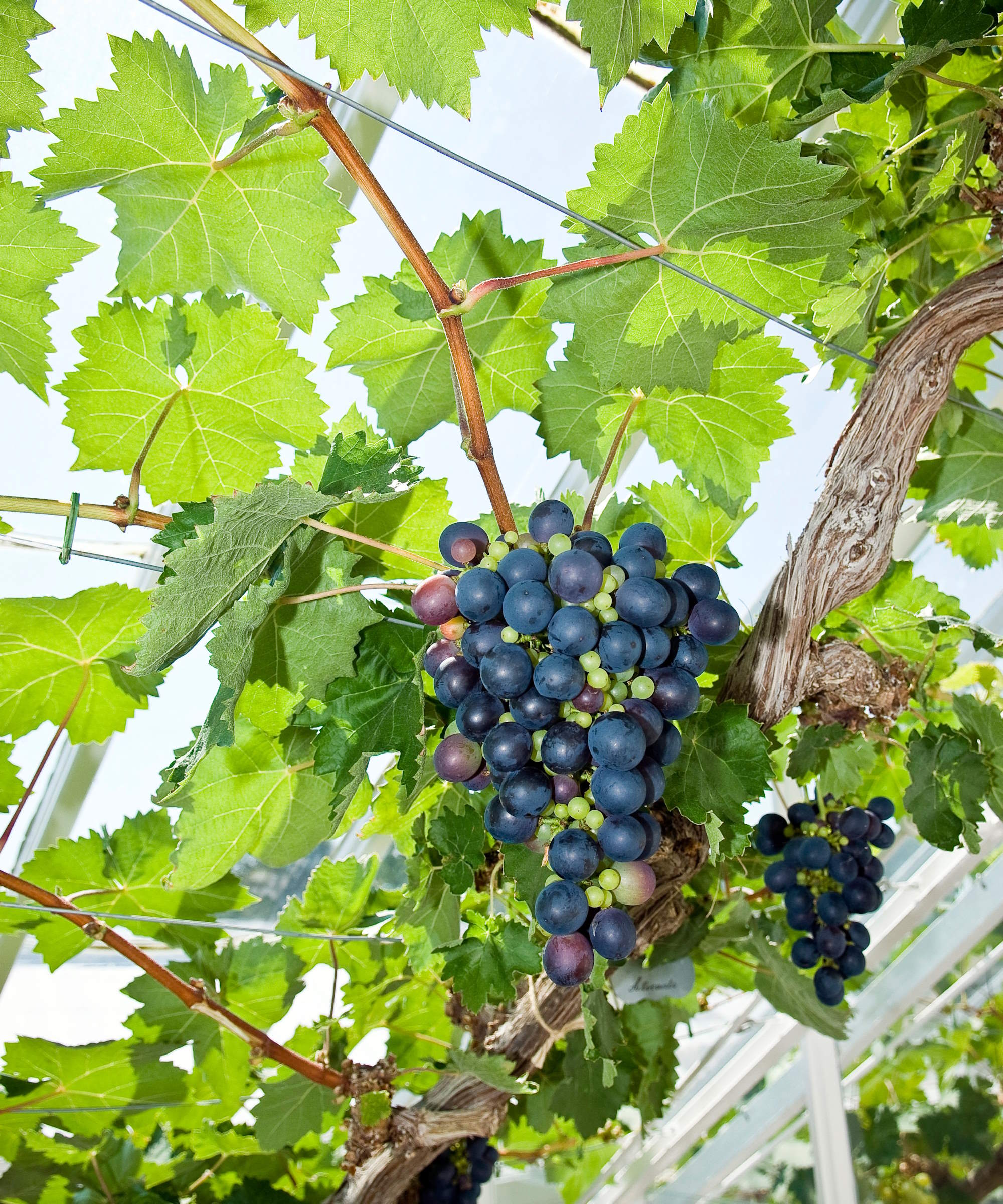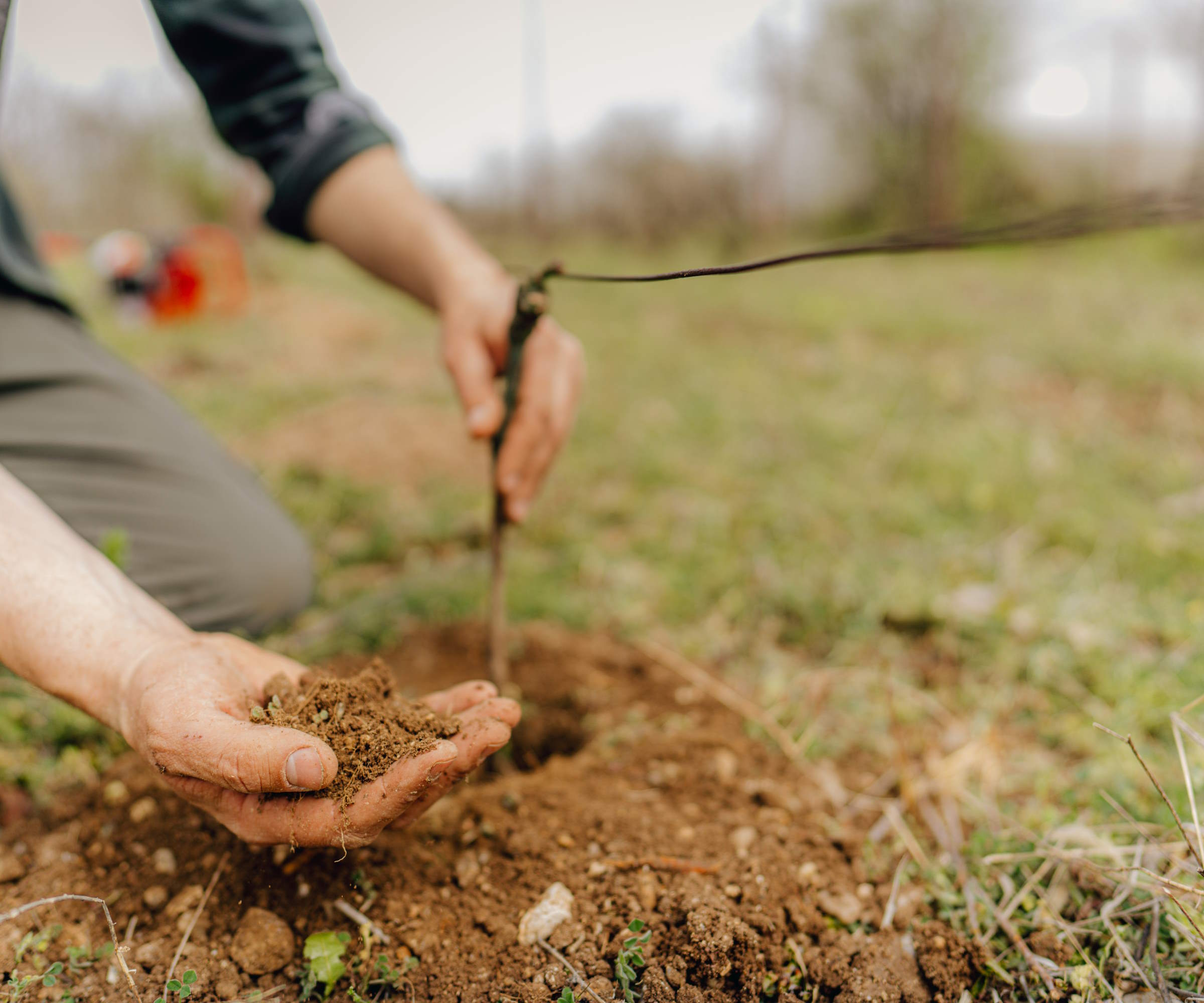How to grow grapes – for healthy vines and great harvests
From propagating to harvesting and everything in between - discover how to succeed with grape vines


Grapes are a vine-growing crop that love heat and warmth. They can be grown outdoors in warmer climates, while the climbing vines are also commonly grown in greenhouses by gardeners in cooler areas.
It does require knowledge and patience to have success cultivating grapes, but it can be very satisfying to pick large, juicy bunches of grapes from your homegrown vines. Plants can be commonly purchased in garden centers, or grown at home from cuttings. Grapes can also be grown from seed, but it is not a traditional way of propagating them.
If you do want to add grapes to your backyard ideas, there are a few key aspects you need to get right. That includes picking the right type for your climate and getting the set-up correct, along with understanding how to water, feed, train, and prune grapes.
We take a close look at how to grow grapes and care for your vines to get a bumper crop each year.

Grapes are grown in large numbers in vineyards, but are suitable for backyards
How to grow grapes at home
There are many different varieties of grapes to grow, coming in several different colors and classed as either wine or dessert grapes. They vary in not only their purpose, but also the conditions in which they need to thrive and produce a good crop - therefore you do need a variety to suit both your location and soil type.
Thankfully, there are types of grapes suited to different climates. So it is likely there is a grape ideal for your location and most commercial varieties of grapes available to buy are self-fertile.

Grapes come in shades of green, red, purple, and black
Where to grow grapes
Grapes are heat-loving plants that want a lot of warmth and sun to produce a great crop of fruits. In warmer climates the vines can be planted outside to soak up the sun and warm temperatures, though in cooler climates they are one of the best foods to grow in a greenhouse. Growing grapes as part of your greenhouse ideas allows them to benefit from the extra warmth provided in such protected growing spaces.
Design expertise in your inbox – from inspiring decorating ideas and beautiful celebrity homes to practical gardening advice and shopping round-ups.
Plant grape vines in a soil type that is rich and well-draining. Incorporating some organic matter, such as compost or well-rotted manure, will improve the moisture retention of the soil and boost the nutrient levels. This will help to ensure healthy root development and strong growth.
The fast-growing flowering vines always require something to climb up. They are often trained to grow up wires attached to walls or fences, or up arches and pergolas. It is recommended to make sure any framework they are to grow up is in place before you plant the grape vine in the garden. The first couple of years of growing will be focused on making sure the plants put down good roots and getting their shape established by training the vine up the support.

Grapes are commonly grown in greenhouses
How to grow grapes from cuttings
Grape vines can be propagated at home from both hardwood and softwood plant cuttings. If you have an existing vine that you like, cuttings are a great way to propagate new versions of it.
Hardwood cuttings can be taken in late fall or winter, when the vine is dormant. Choose healthy vines that are pencil-thick and have grown in the last year.
Cut a section around 14-16 inches in length and place these in a cold, but not freezing, place over winter to then be planted in spring. They can be planted either outside in the ground, or in pots filled with compost and placed in a protected environment, such as a greenhouse or cold frame. Place the cuttings in water for a few hours before planting and make sure two-thirds of the cutting is below the soil when planted. Keep them moist and they can be transplanted into their final position the following spring.
Softwood cuttings can be taken in late spring or summer. Use clean and sharp tools to snip around four inches of healthy non-flowering stems. Remove the lower leaves and trim below a node, before placing the cutting in a small pot filled with well-draining compost. Keep it moist and somewhere warm, ideally with a plastic bag or humidity dome placed on top of the pot. You can get Plant Nursery Pots with Humidity Domes, such as these at Amazon, that are ideal for softwood cuttings.

Grape vines can be propagated successfully from cuttings
How to grow grapes from seed
You can grow grapes from seed at home, though it is a slow process and not a usual way of propagating them. This is because it is not guaranteed they will replicate the quality of the parent plant.
Seeds first need to be extracted from ripe grapes by washing away the flesh, before being stratified in the refrigerator for around three months to recreate the winter environment and prompt the seeds into growth mode.
‘Place the cooled seeds into little pots that include a seed starting mix that drains properly,' recommends Aaditya Bhatta, editor and founder of Plants Craze. ‘Maintain a slightly damp but not damp soil and supply some warmth (around 70°F) using a heat pad or in a sunny spot. There is a 2-4 week germination period.
‘Once seedlings have two sets of true leaves, transplant them to larger pots with a good quality potting mix.’
The young grapes can be grown in a warm environment and then the seedlings can be transplanted into their final growing spot when they have reached around 12 inches tall.

Aaditya Bhatta is the founder and editor of Plants Craze, a website that offers tips and tricks on gardening and plant care. He has been a plant enthusiast and plant parent for over a decade.

Growing from seeds is not a common way to grow grapes
How to plant grape vines
Grape vines are commonly sold in garden centers grafted onto a rootstock and can either be purchased as potted plants or bare-root. The former are available year-round, while bare-root plants tend to be available from fall to spring.
Grape vines are ideally planted during their dormant period, with early spring the ideal time to plant them once the risk of frosts has passed. The ideal time will vary depending on your US hardiness zone, or if you are planting the grapes outdoors or in a backyard greenhouse.
If you are planting bare root grape vines, soak the roots in water for 3-4 hours and plant them so the lowest bud sits just above the soil and the first roots just below. Grafted grapevines will need to have the grafted point above the soil level when they are planted.
To plant any grape vines, dig a large hole to accommodate the roots of the plants and give each vine a large amount of space. You want to have vines at least 6-10 feet apart, depending on the variety, and this can go up to 16 feet apart if you are growing muscadine grapes.
You can see the range of grape vines available at Fast Growing Trees

Grapes should be planted into fertile soil in the spring
How to care for grapes
Grapes require regular watering when they are young. They are hungry plants and, although they do become quite drought tolerant once they are established, even older vines will benefit from watering during dry conditions. Vines growing in greenhouses or in containers will require extra watering than vines growing outdoors. Always water the base of the vines and not the foliage, as this can cause fungal issues, including powdery mildew.
For the first couple of years, simply apply organic mulch, such as compost or well-rotted manure, around the vines to feed them. Once established, from their third year onwards, the vines benefit from a feed in early spring.
‘Balanced fertilization, especially during the growing season, supports healthy vine development,’ says Alex Testel from Frugal Frontier. ‘Apply minimal fertilizer, only when necessary, and in early spring to avoid overfeeding.’ A good fertilizer to use is a slow-release general fertilizer with a high level of potassium, such as the All Purpose Plant Food available at Amazon.
Annual pruning is vital in keeping grape vines healthy and productive. It is important to understand when to prune grape vines, as not cutting them during their dormancy period will cause them to bleed sap and stress the plant. Grapes growing in a greenhouse are pruned in December or early January, while vines growing outdoors can be pruned from January through to March.
For the first few years after planting, you want to remove any flowers that form. Leaving fruit to develop will drain the vine’s energy reserves away from establishing a strong root system. The focus for those formative years is to develop the shape of the main stems and establish the vine. In the third year, only let a few bunches develop once the shape is set.
As for how to prune established grape vines, around 80 percent of the growth is removed from the vine during pruning - as grapes produce fruit on new shoots. A mature vine will have all shoots from the main trunks cut back down to two or three buds each winter or spring. The newly-developed shoots carrying the year’s fruit are then pinched back each summer. This is to focus the energy into developing a select few large bunches of grapes per stem, rather than lots of smaller ones.
Grapes will ripen throughout late summer and the end of fall, depending on the variety. Alex Testel advises to ‘observe the color change and sugar accumulation in the berries’ to recognize when the time is right to harvest the grapes. The grapes are ripe when they all turn their characteristic color, be it red, purple, or green. Another great way to check is also to taste the grapes. Carefully remove the clusters whole from the vine with sharp shears or scissors, and handle them with caution.

As an avid gardener and horticulture expert, Alex specializes in vineyard
management and the cultivation of grape vines. His approach combines
traditional techniques with modern sustainable practices, focusing on
creating thriving, productive vineyards. Through his platform, Alex aims to
educate and inspire others on the art of growing grapes and the joys of
viticulture.
FAQs
Can you grow grapes from a grape?
It is possible to grow grapes from seeds harvested from another grape, however it is unlikely that the resulting plant will replicate the original. If you do have, or know, an existing vine that you like, then taking cuttings is the best way to get another.
It is not recommended to attempt to grow grapes from store-bought grapes as you will not know if the type of grape will suit your climate and the resulting plant will not produce grapes of the same quality.
How many grapes do you get from one plant?
It will depend on the variety of grapes you are growing, the age of the vine, and the conditions of the growing season, but you can get anywhere between 10 and 20 pounds of grapes off a healthy and established vine each year.
Growing fruit vertically, such as with grape vines, allows you to take advantage of otherwise unused space on walls or fences. This makes vertical growing great for small backyard ideas or small vegetable garden ideas. As well as vines, you could also consider growing a range of fruit in trained forms, such as espaliers, cordons, or fans.

Drew has worked as a writer since 2008 and was also a professional gardener for many years. As a trained horticulturist, he worked in prestigious historic gardens, including Hanbury Hall and the world-famous Hidcote Manor Garden. He also spent time as a specialist kitchen gardener at Soho Farmhouse and Netherby Hall, where he grew vegetables, fruit, herbs, and cut flowers for restaurants. Drew has written for numerous print and online publications and is an allotment holder and garden blogger. He is shortlisted for the Digital Gardening Writer of the Year at the 2025 Garden Media Guild Awards.